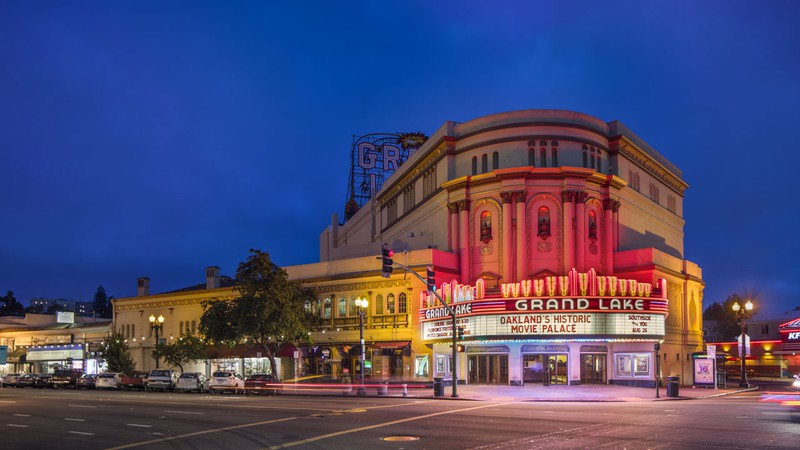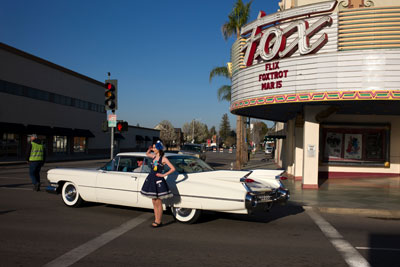Some of California’s shrines to cinema’s golden age still stand—but even the famous ones are endangered.

Oakland’s Grand Lake Theatre, built in 1926. BondRocketImages Shutterstock
The renowned exhibitor Marcus Loew commented, “We sell tickets to theaters, not movies.” It’s hard to imagine someone boasting like that about the average multiplex. Classic movie-theater architecture of the past was sometimes palatial, sometimes bombastically kitschy, sometimes both at once. In these grottos of stone, steel and plaster, the exotic was commonplace. Theaters sold reveries of Arabia, China, imperial Spain. Later they went modern—or rather, Moderne—when Art Deco replaced Gothic influence.
The picture palaces that survive today show what people once thought of the movies, in the same way that cathedrals show what people once thought of religion.
Benign California weather has kept a few of these big theaters alive past the century mark. But even the famous ones are endangered. The California in Berkeley opened in 1914 as the T and D Theater, with the primordial sword-and-sandals epic Cabiria, After a century, it was closed in 2020 by Covid. Now it’s slated for conversion into apartments. Berkeleyside reporter Alice Jurow argues spiritedly against that fate. And the Shattuck Theater, a Berkeley plex decorated with a twinkling star ceiling and plaster Egyptian-style moldings, closed right after Memorial Day.
Aside from repurposing the Fox and Spreckels theaters (more on those below), San Diego also has been ruthless with its movie palaces. Give the locals points for preserving a 40-foot woman that once lured passersby into a show. The neon drum majorette mascot of the bulldozed Campus Drive-In (1948) survives on as the advertising sign on the College Grove shopping center.
Charles Lee—also was the architect of that beloved and since-closed San Diego rep house, the Ken (1947)—designed the unusual moderne Loma Theatre (1945). The free-standing blade is outside the main building, with its military-looking medallions. Closed as a theater, the building is still in the story-telling business; its new tenant, the Bookstar bookstore, lets one see the design of the place.

Some of the most beautiful old theaters in the state are now mixed-use entertainment venues: San Diego’s Spreckels Theater (1912); the Moorish palace known as the California Theatre in San Jose (1924); and the astonishing Art Deco Paramount in Oakland (1931), which is like something straight out of the Emerald City. These aren’t the kind of venues I sought out for this list, on the grounds that they’re only showing movies on special occasions. But L.A.’s Orpheum, Bakersfield’s Fox and Redding’s Cascade theaters were too grand not to sneak into a big ten list, even if they’re primarily concert venues.
Imagine all the dreaming that went on in these buildings.
The Castro Theatre is as essential to the spirit of San Francisco as the Golden Gate Bridge. Can someone say they really lived in that city if they didn’t hear the Castro organist play the anthem “San Francisco” at least once? The remarkable quality of the Castro is that it was just a neighborhood movie house, once; in the scheme of 1920s picture-palace building, it wasn’t that enormous, even with its intricate facade built to mimic nearby Mission Dolores. A celebration of its 100th birthday will take place June 22 with a daylong mini-fest of films shot in San Francisco; the climax is Steve McQueen’s cop drama Bullitt, capped with a car chase that still twists the nerves. The celebration is tinged with sadness. The Castro Theatre is being redone to accommodate its current status as a live-music and mixed-use venue, and cinema-goers who want their cherished revival house back will have no place else in the city to see a film on 70mm. They correctly point out that remodeling will spoil sight lines for film events, since the once well-raked auditorium will be a flat dance floor. Nevertheless, the theater itself will still be there as a thing of beauty.
Citizen Kane premiered here. This Hollywood Boulevard theater, executed in a haute-Mexican ultra-baroque style, has had more lives than a cat. It’s survived closings, abandonments, pandemics, earthquakes and flooding. Today it’s the glittering auditorium where Disney premieres its movies; expensively renovated, it houses the old Fox San Francisco’s organ. For many children, this will be their first experience of the whole moviegoing equation, with mammoth surroundings, gilded walls, and a wide screen. It’ll sure beat watching Toy Story on an LED screen in the back seat of a minivan.
The situation of this waterside palace resembles the Jefferson Memorial … if you think of Oakland’s Lake Merritt as analogous to D.C.’s Tidal Basin. The Grand Lake Theatre is capped by a landmark animated sign, just recently converted to LEDs; an electric fireworks display goes off every weekend night. The idea here is that the show ought to begin before you get inside. The still impressive main auditorium, with its silver and burgundy curtain, is the site of the annual Noir City film noir festival. Posh as it is, it hosts $6 Tuesdays. Exhibitor Alan Michaan reaches out to the community with overtly political marquees, which became a landmark of their own. The theater is particularly welcoming for people who’d rather go to the movies on Christmas with Chinese food afterwards. For years, the Grand Lake served up lush holiday spectacles set in Hogwarts, Middle Earth or Asgard.
The evening commuter emerging from the Caldecott Tunnel has a pretty sight in the twilight: the blade of this theater’s marquee, glowing in rainbow colors through the redwoods. The Orinda Theatre is the centerpiece of its namesake village; incidentally, “Orinda” was the nom de plume of an obscure female poet of the English Restoration, whose work seems proto-feminist if viewed in the right light. This independent theater is a too-well-kept secret. It’s easily accessible by a BART station 500 paces away. It’s highly inexpensive ($10 tickets), and has a first-rate bar behind the counter. It serves up first-run A-list movies as well as nostalgia entertainments. Bay Area viewers who moan about the crowding and expense of going to see blockbusters with their families need to know about the Orinda. It caters to nostalgia viewers with a regular series of ’50s sci-fi. And recently there was a day devoted to the utter weirdness of Sid and Marty Krofft’s 1970s human puppet shows. The main auditorium is so vast you’d never really know it had been multiplexed with a pair of small side pocket theaters. Those missing the newly bulldozed Shattuck can enjoy the Egyptian tomb decor in the Orinda’s small screening room sized theater. As for the main auditorium, it’s unmissable, decorated with phosphorescent murals of celestial decor, nubile star maidens, and Saturn-shaped ceiling lights.
David Packard Jr., heir to the Hewlett-Packard fortune, brought this Palo Alto theater back to its original jazz-age beauty in furnishings and technology, and installed a superb Wurlitzer for silent films. It’s booked as astutely as many a renowned cinematheque. Like the Orinda, the Stanford Theatre isn’t a rich person’s pleasure: tickets are priced at a pittance, and the concessions cost what they would have cost 50 years ago. Supposedly more people saw Casablanca in revival here than they did anywhere else (was there, indeed, a better place to see Casablanca: as Umberto Eco observed—not a movie but the movies). An adjacent movie poster gallery displays some of the Stanford Theatre Foundation’s collection; Mr. Packard’s favorites, Judy Garland and Audrey Hepburn, are well represented. It’s been closed since March 2020 for structural upgrades and the duration of the epidemic, but is rumored to be reopened this summer.
“The castle of your dreams,” said a typically modest Jack Warner. When I was a young man, I wore an orange blazer and took tickets at the Warner Beverly Hills (1931), later renamed the Pacific Beverly Hills. Once, the noble old theater had premiered Lawrence of Arabia. In my time, it was a coop of turkeys; the heinously bad booking pushed the theater in front of the bulldozers. This later-demolished palace was one of a set of identical triplets; its sister in Huntington Park was turned into a gym and then closed. But San Pedro’s Warner Grand, third of the siblings, is in excellent health; it’s an ornate yet compact small-town palace now operated by the city of Los Angeles. Ready for service as an exterior whenever someone is shooting a movie about the 1930s, it is rented out regularly for one-night-only films, such as a Christmas screening of It’s a Wonderful Life, and also hosts the San Pedro Film Festival.
From the concrete frieze to the WPA-style working-man murals, Redding’s Cascade Theatre is a splendid example of Art Deco unleashed, a style reflecting 1930s tensions between full-throated populism and Fountainheadean architectural arrogance. An article on the indispensable site Cinema Treasures tells of the building’s return from skid-row dereliction. It makes the interesting note that Redding once had a population of 7,000 and that the Cascade’s capacity was 1,350. When it was first opened, then, more than a seventh of the city could fit inside at once.
The theater where Michael Jackson sat eating popcorn in the “Thriller” video. This deluxe downtown Los Angeles theater is particularly honored by the Los Angeles Historic Theatre Foundation, the point-people on the preservation of the city’s remaining palaces. The rooftop sign of this lavish building is a landmark, used in every third music video. The stained glass and marble inside marked this as one of the big West Coast destinations for vaudeville acts. (In a way, it still has the variety theater quality; big-name singers share the stage on different evenings with drag competitions and women’s jiu-jitsu tournaments.)
The elegant Fox West Coast theaters have proven to last almost a century; they survive as concert venues throughout the state in Oakland, Redwood City, Riverside—and in San Diego as the theater now known as the Copley Symphony Hall, and in San Jose as the glorious California Theatre (formerly the Fox California). The 4,600-seat Fox San Francisco (1929), the biggest theater west of Chicago, was the monarch of them all; it had not just a main theater organ, but an additional organ in its lobby for crowds waiting for room inside. Despite protests, the Fox San Francisco was knocked over in 1963 to make room for a grim office building. (The SF Weekly’s Bob Calhoun, writing while holding a flashlight under his chin, addresses the strange rumors of a Satanic revenge curse on the office building, laid by organist/dark priest of eeeeeevil Anton LaVey.)

The Fox Bakersfield is all the more beautiful in contrast to its town of fields and oil wells; inside are painted heavens and false walls ornamented to look like an Italian garden. The proud clock tower outside survived the earthquake of 1952. And it’s now a centerpiece to Bakersfield’s reviving downtown (escapees from L.A. prices are coming to live there; local boosters are promising reasonable prices and kind neighbors).
Featured in The Player and La La Land, this theater is currently leased by the non-denominational Mosaic ministry. The decaying interiors have been painted in a way that can be reversed in the future, and the marquee was relamped with fresh neon. Like so many of the buildings in its South Pasadena vicinity, it’s rich with California Arts and Crafts tile work. Despite the Venetian name, it’s done, as Walter Neff says in Double Indemnity, in that California Spanish style everyone was nuts about in the 1920s. The Rialto never underwent a multiplexing and thus is estimated to be the last single-screen theater left in L.A. Fixing it will be an expensive job. But given the deep wallets that abound in the movie business, as well the Pasadena area’s love of the antique, one hopes that Friends of the Rialto can find more well-off friends.
Article exploring songs, books, movies and other works from art and culture which feature our beautiful state.